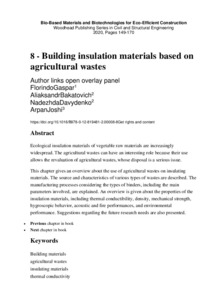Пожалуйста, используйте этот идентификатор, чтобы цитировать или ссылаться на этот ресурс:
https://elib.psu.by/handle/123456789/28796Полная запись метаданных
| Поле DC | Значение | Язык |
|---|---|---|
| dc.contributor.author | Gaspar, F. | - |
| dc.contributor.author | Bakatovich, A. | - |
| dc.contributor.author | Davydenko, N. | - |
| dc.contributor.author | Joshi, A. | - |
| dc.date.accessioned | 2022-01-24T13:37:11Z | - |
| dc.date.available | 2022-01-24T13:37:11Z | - |
| dc.date.issued | 2020 | - |
| dc.identifier.uri | https://elib.psu.by/handle/123456789/28796 | - |
| dc.description.abstract | Ecological insulation materials of vegetable raw materials are increasingly widespread. The agricultural wastes can have an interesting role because their use allows the revaluation of agricultural wastes, whose disposal is a serious issue. This chapter gives an overview about the use of agricultural wastes on insulating materials. The source and characteristics of various types of wastes are described. The manufacturing processes considering the types of binders, including the main parameters involved, are explained. An overview is given about the properties of the insulation materials, including thermal conductibility, density, mechanical strength, hygroscopic behavior, acoustic and fire performances, and environmental performance. Suggestions regarding the future research needs are also presented. | ru_RU |
| dc.language.iso | en | ru_RU |
| dc.publisher | Elsevier | - |
| dc.title | Building insulation materials based on agricultural wastes | ru_RU |
| dc.type | Article | ru_RU |
| dc.identifier.doi | 10.1016/B978-0-12-819481-2.00008-8 | - |
| Располагается в коллекциях: | Публикации в Scopus и Web of Science | |
Файлы этого ресурса:
| Файл | Описание | Размер | Формат | |
|---|---|---|---|---|
| 149-170.pdf | 47.26 kB | Adobe PDF |  Просмотреть/Открыть |
Все ресурсы в архиве электронных ресурсов защищены авторским правом, все права сохранены.